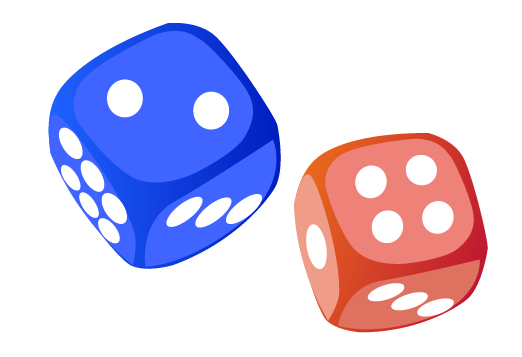Rules and Formulae
This chapter explores rules and formulae. It covers using letters to represent unknown numbers, substituting numbers into simple expressions and formulae and understanding basic fomulae.
Fomulae contain letters which represent unknown values. The values usually are required to find out the final outcome depending on the given values replacing the uknown values.

Above is two dice with two different numbers shown. We can represent the red dice with r and the blue dice with the letter b. If we wanted to write the total values for both values we would write.
![]()
And that is true because;
![]()
We have formed a formulae for the values shown on the dice and when we replaced the letters with the values the outcome was true.
John is arranging a patry for his friends. He has 8 friends. Below are some of the rules he constructs to check what he needs.
- One pizza for every 4 people
- 2 ballons for every person
- 3 biscuits per personplus 5 extra
- 8 cups is needed plus 6 extra
- 3 apples less the number of friends
- One bottle of pop for every two friends
John has managed to form some rules in human language. These rules could be written in a more simplified easy to remember mathematical way.
For example John rule states; Two ballons for every person. Here we could represent ballons with the letter b. b is number of ballons. We can represent people or persons with p. We know 2 ballons for every person will be required. This must mean, the number of ballons will be double the number of people which we can write as;
![]()
Suppose John had 10 friends coming at the party, we could use the formula above to find out how many ballons he would need. We write;

John would need 20 ballons.
John’s other rule states 3 apples less the number of friends. We could let a represent apples, p represent people. Then we write;
![]()
John’s other rule states; 3 biscuits per person plus 5 extra. Suppose there were 10 of John’s friends at the party, John’s human formula states that each person would need 3 buscuits then another 5 as extra (maybe just in case something goes wrong). So;
![]()
Add another 5 extra.
![]()
To form a formulae we write;
![]()
We could simplify 3xp by simply writing it as 3p, therefore;
![]()
That’s the end of this chapter. Remember formulae contain letters which represent unknown values. In most cases to solve the all formula expression you would need to replace all the unknown values.
